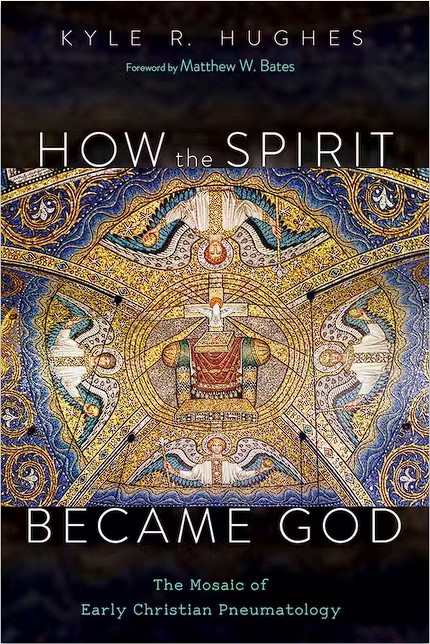Kyle Hughes: How the Spirit Became God
 Kyle R. Hughes, How the Spirit Became God: The Mosaic of Early Christian Pneumatology (Cascade, 2020), 176 pages, ISBN 9781532693748.
Kyle R. Hughes, How the Spirit Became God: The Mosaic of Early Christian Pneumatology (Cascade, 2020), 176 pages, ISBN 9781532693748.
The title of this book may be initially off-putting to some, as though the author is proposing a view of the Holy Spirit akin to what is known as “adoptionist Christology.” But in the foreword, Matthew Bates makes it clear this is not the case: “While the revelation of the divinity of the Spirit (as part of the Christian doctrine of God) has an origin in time, nevertheless the Spirit’s divinity is not constrained by time or by our process of discovery” (xi). So, the book is not about the Spirit becoming God, as though there “was a time when he was not” God, but about how the Spirit came to be understood as being God.
The author, Kyle Hughes, apart from being an ordained deacon in the Anglican Church in North America, is also chair of the history department at Whitfield Academy in Atlanta, Georgia. He brings both a doctrinal lens and a historian’s perspective to this topic.
Chapter one, “The Problem of the Holy Spirit,” starts off by tackling some of the difficulties raised by the ways the Spirit is portrayed in Scripture. While the Father and Son are consistently portrayed in personal terms, phrases that depict the Spirit being “poured out” on people, or “filling” them, seem to suggest an inanimate substance rather than a personal being (3). Hughes then outlines how this historical study will not simply summarize the dogmatic teachings of various church fathers, but dive into how the early church’s methods of biblical interpretation that informed their declarations about the Godhead. Hughes proposes that the development of pneumatology in the first few centuries of the Christian era was based first on ideas being grounded in Scripture, while also including the church’s lived experiences of the Holy Spirit in light of Scripture.
The book is not about the Spirit becoming God, as though there “was a time when he was not” God, but about how the Spirit came to be understood as being God.
Chapter three deals with “The Spirit and Christian Identity.” In discussing how the increasingly Gentile church came to see itself as no longer simply a messianic Jewish sect, Hughes looks at the Epistle of Barnabas and the writings of Justin Martyr. Barnabas argues that not only did the Spirit inspire the writers of the Ole Testament to look forward to Christ, but the Spirit himself looked forward to Christ, which is a personal activity rather than that of an impersonal force (42). Hughes points out that Justin wrote about the ongoing presence of the charisms in the second century, in the lives of both male and female believers, which means that the Montanists and other charismatic groups in the early church were not as innovative as some versions of history would assume (48-49). Justin also argued that just as the central Old Testament figures had gifts of the Spirit, the presence of these gifts among Christians showed that God’s Spirit was now upon them and had departed from the Jewish people as a group, indicating that the Christians had properly recognized the arrival of the Messiah.
If Jesus saw the Spirit, whom the Father would send, as another counselor like himself, then the Spirit must be a personal being, just as Jesus was.
The fifth chapter, “The Spirit and the Divine Economy,” examines Iranaeus’ presentation of the Spirit as the one who gives life, prepares believers for eternal life, reveals God across all of Scripture, and realizes the risen Christ’s presence in redeemed individuals (80-81). The work of Tertullian is further examined as well, discussing how his battle against modalistic monarchianism led to the development of trinitarian language, with Tertullian showing how that activities of the Father, Son, and Spirit are carried out by three divine Persons, and not simply one God playing three roles (85). The author also points out that Tertullian’s particular language sets up a problem for later trinitarian theologians, that of subordinationism (87). Novatian’s contribution of the eternal distinction of the Son from the Father is discussed (92), as is Origen’s articulation of the eternal existence of the Spirit with the Father and the Son (95).
Basil of Caesarea insisted that three distinct persons in the Godhead did not imply polytheism.
The church’s teaching on the divine personhood of the Spirit—and thereby of the Trinity—did not descend fully-formed from heaven on golden tablets but was hammered out over the centuries through theological reflection on Scripture in the midst of the Spirit’s working among believers.
I found this book to be very helpful in understanding the development over time of the doctrines we learn today in basic Christian discipleship classes and courses of systematic theology. The church’s teaching on the divine personhood of the Spirit—and thereby of the Trinity—did not descend fully-formed from heaven on golden tablets but was hammered out over the centuries through theological reflection on Scripture in the midst of the Spirit’s working among believers. I highly recommend Hughes’ volume to students of historical theology, as well as to anyone who desires to know more about “how we got here.”
Reviewed by Brian Roden
Publisher’s page: https://wipfandstock.com/9781532693748/how-the-spirit-became-god/


